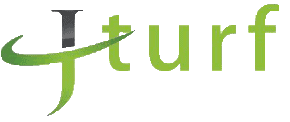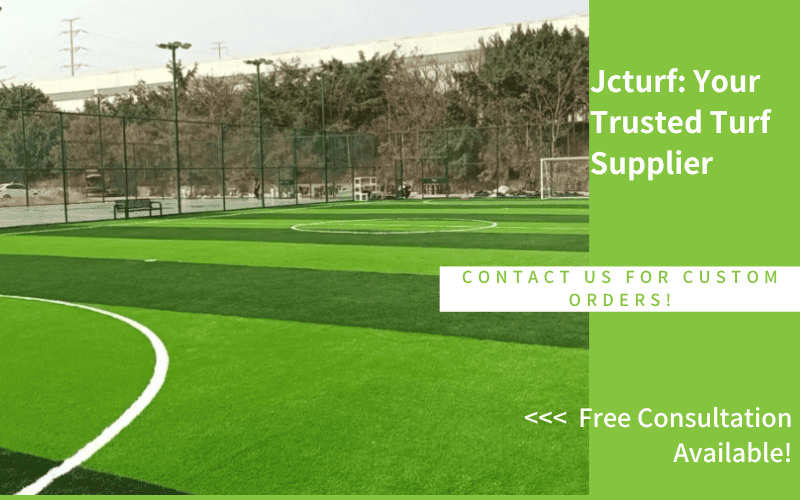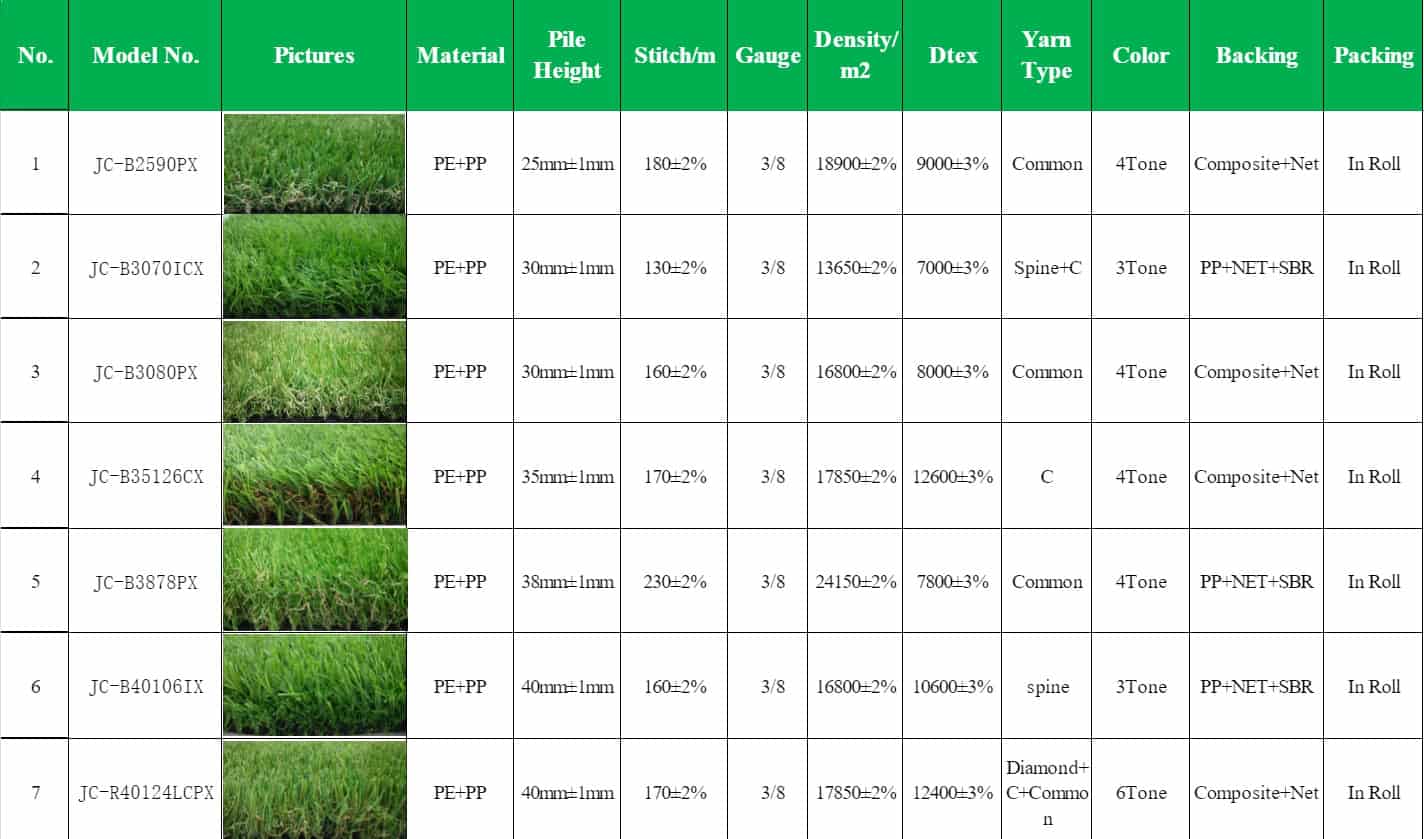Selecting the ideal turf for your football field is essential for optimizing performance, durability, and player safety. With options ranging from natural grass to artificial and hybrid turf, each type offers distinct benefits tailored to factors like usage, climate, and budget.
Beyond these broad categories, artificial turf encompasses specialized subtypes—such as filled, non-filled, and monofilament designs—crafted for specific performance needs. In this guide, we’ll explore the pros and cons of each turf type, compare their ideal use cases, and provide practical insights to help you choose the perfect solution for your field.
Types of Football Turf: Pros, Cons, and Best Use Cases
Natural Grass
Natural grass football fields are made from real grass that grows in the ground. Football fields are planted with grass that’s specifically picked for its durability and capacity to endure heavy use. Well – liked types such as Bermuda grass, Kentucky bluegrass, and ryegrass are chosen according to local climates and soil situations.
Pros:
- Original Feel & Ease: Offers improved impact reduction, lowering injury chances. The soft surface enhances player comfort during long matches or training.
- Refreshing Coolness: Maintains a cooler surface than synthetic turf, enhancing player comfort during sweltering weather.
Cons:
- High Maintenance: Requires regular watering, mowing, reseeding, and aeration to maintain a healthy playing surface. This may result in increased operating expenses and a greater time commitment.
- Weather Dependent: Heavy rain can lead to muddy, slippery conditions, while extreme heat can cause the grass to dry out, affecting playability.
Best Use Case: If your facility has the resources for continuous maintenance and you’re located in a climate that supports natural grass, it’s ideal for professional sports venues where player comfort and aesthetics are a priority.
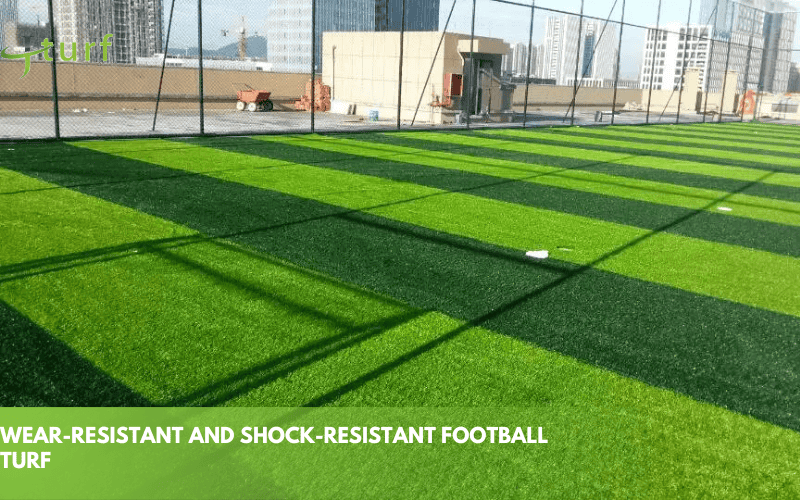
Artificial Grass
Synthetic turf, commonly referred to as artificial grass, is crafted from human-made fibers engineered to mimic the appearance and texture of natural grass. It is typically composed of polyethylene, polypropylene, or nylon fibers, all of which are designed to mimic the look and texture of natural grass while offering high durability and resistance to wear.
Pros:
- Minimal Maintenance: Requires no watering, mowing, or reseeding. Just periodic cleaning and brushing to keep it looking good.
- All-Weather Resilience: Functions optimally across diverse climates—rain or scorching heat—ensuring year-round usability in outdoor and indoor arenas.
Cons:
- Warmer Surface: Can heat up in direct sunlight, which may impact player comfort, especially during summer or hot weather.
- Less Natural Feel: While it looks like grass, it doesn’t provide the same natural feel underfoot, which some players may find less comfortable compared to natural grass.
Best Use Case: If you need a durable, low-maintenance field that can withstand heavy traffic, artificial grass is the best option. It’s especially suited for multi-use sports complexes, urban areas, and locations with extreme weather conditions, providing a reliable surface even under heavy foot traffic.
Hybrid Turf
Hybrid turf is a combination comprising natural grass and artificial fibers. The synthetic fibers are integrated into the natural grass to enhance durability while maintaining the natural feel of real grass. Typically, the artificial fibers make up a small percentage (less than 5%) of the total field surface, reinforcing the natural grass, especially in high-traffic areas.
Pros:
- Enhanced Durability: Hybrid turf is more durable than pure natural grass and can handle heavy use, making it ideal for fields with high traffic. The synthetic fibers help reduce wear and tear, prolonging the field’s life.
- Natural Look and Feel: Retains the aesthetic appeal of natural grass while improving performance and resilience. This renders it a favored choice for venues aiming to achieve the aesthetic and tactile qualities of natural grass while minimizing maintenance demands.
Cons:
- Higher Initial Cost: The cost to install hybrid turf is typically higher than both natural and artificial grass, as it combines both elements.
- Ongoing Maintenance: Though it requires less upkeep than natural grass, hybrid turf still needs some maintenance, such as occasional mowing and care for the natural grass portion.
Best Use Case: Hybrid turf is perfect for high-traffic fields that need to balance durability with the appearance and feel of natural grass. It’s ideal for venues that host frequent events, training sessions, or professional matches, offering the best combination of longevity and natural aesthetics.
Football Field Turf Types Comparison Table
The table below provides a quick comparison of Natural Grass, Artificial Grass, and Hybrid Turf, focusing on maintenance, durability, and costs. It helps you quickly assess which turf type best fits the needs of your football field.
| Aspect | Natural Grass | Artificial Grass | Hybrid Turf |
| Maintenance Requirements | High (regular watering, mowing, reseeding) | Low (no watering, mowing, or reseeding) | Moderate (requires mowing and some care) |
| Watering | Frequent | None | Moderate (some watering needed) |
| Mowing | Frequent | None | Moderate |
| Reseeding | Frequent | None | Occasional reseeding |
| Cleaning | Occasional cleaning | Occasional cleaning | Occasional cleaning |
| Durability | Moderate (needs frequent repairs) | High (withstands heavy use without damage) | Moderate (more durable than natural grass but less than artificial) |
| Longevity | Short (requires constant upkeep) | Long (can last up to 15 years) | Moderate (lasts longer than natural grass but shorter than artificial) |
| Installation Cost | Lower initial cost | Higher initial cost | Higher initial cost |
| Maintenance Cost | High (long-term maintenance required) | Low (minimal maintenance required) | Moderate (less than natural grass but more than artificial) |
In addition to the three main categories of turf mentioned above, there are many different types of artificial turf used in production and application. Let’s explore them together!
Exploring Different Types of Artificial Turf for Football Fields
Artificial turf types for football field vary by infill, yarn, height, density, and use, each tailored for performance, durability, and maintenance needs.
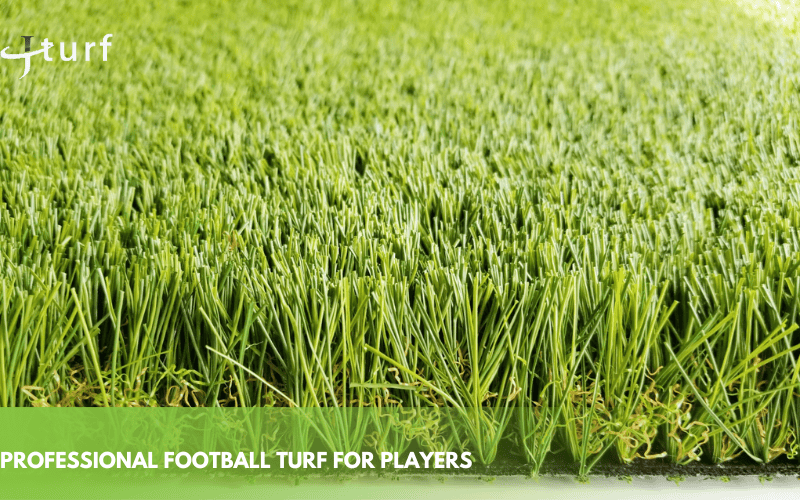
Polyethylene (PE)
Polyethylene is one of the most popular materials for artificial turf, especially for football fields. Its soft texture is gentle on players’ skin, making it a preferred choice for professional and recreational sports.
- Features: Soft, durable, and highly elastic. Provides a natural grass-like feel and appearance.
- Advantages: Skin-friendly, resistant to UV rays, and suitable for heavy use.
- Applications: Ideal for football fields due to its durability and player comfort.
Polypropylene (PP)
Polypropylene turf is a budget-friendly option for artificial grass. While not as durable as PE, it is suitable for fields with lower traffic and provides a practical solution for cost-conscious projects.
- Features: Lightweight and cost-effective, but less durable compared to PE.
- Advantages: Affordable and suitable for areas with lighter usage.
- Applications: Often used for practice fields or recreational spaces.
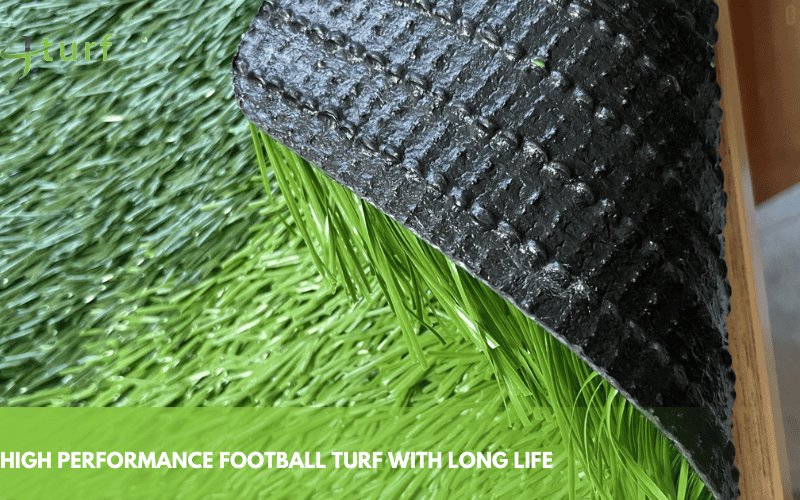
Nylon
Nylon is the strongest material used in artificial turf. Its superior durability makes it ideal for high-traffic fields, though its stiffer texture and higher cost make it less common for football fields compared to PE or PP.
- Features: Extremely strong and durable, with excellent resistance to wear and tear.
- Advantages: Long lifespan and can withstand intense usage.
- Disadvantages: Stiffer texture and higher cost compared to PE and PP.
- Applications: Best for high-traffic areas or mixed-use sports fields.
PE+PP Artificial Turf
PE+PP artificial turf blends the strengths of both materials, offering a versatile solution for football fields. It provides a balance of comfort, durability, and affordability, making it a popular choice for a variety of sports applications.
- Features: Combines the softness and elasticity of PE with the cost-effectiveness and lightweight nature of PP.
- Advantages: Balanced performance, offering durability, comfort, and affordability.
- Applications: Widely used for football fields that require both quality and cost-efficiency.
Classification Based on Infill Material
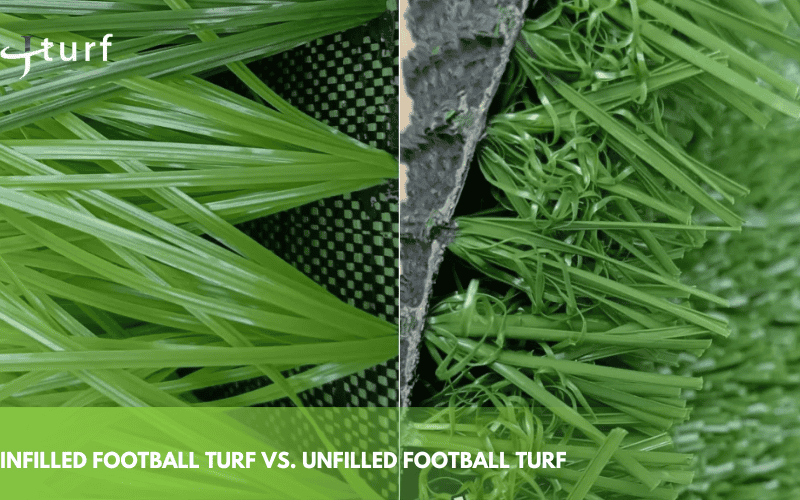
Filled Artificial Turf
- Characteristics: Requires infill materials such as rubber granules, sand, or a combination to provide cushioning and stability, mimicking the performance of natural grass.
- Applications: Professional football fields, training grounds, and FIFA-certified venues (e.g., FIFA Quality Pro).
- Advantages: Superior shock absorption and ball roll performance, ideal for high-intensity matches.
- Disadvantages: Higher maintenance costs, with potential infill displacement or degradation over time.
Non-Filled Artificial Turf
- Characteristics: No infill required, relying on high-density yarns and specialized designs for support and elasticity.
- Applications: Amateur fields, school playgrounds, or indoor football pitches.
- Advantages: Low maintenance, eco-friendly, and quick to install.
- Disadvantages: May have reduced durability and shock absorption compared to filled turf, suitable for low-intensity use.
Classification Based on Yarn Structure
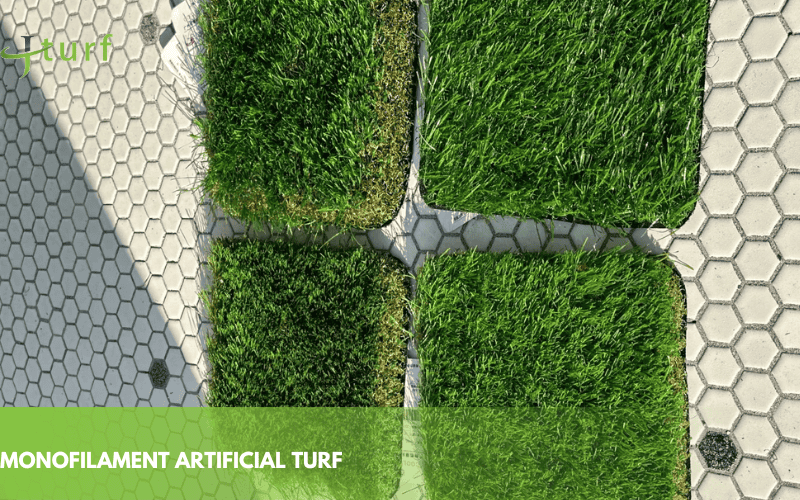
Monofilament Turf
- Characteristics: Single-fiber structure with shapes like U-type, S-type, diamond-type, or C-type, designed for durability and uprightness.
- Applications: High-intensity professional football fields requiring long-term durability.
- Advantages: High fiber strength, excellent wear resistance, and a smooth surface.
- Examples: U-type monofilament, diamond-type monofilament, S-type monofilament.
Fibrillated Turf
- Characteristics: Yarn is slit into a net-like structure after tufting, providing good infill retention.
- Applications: Multi-sport fields or older football pitches.
- Advantages: Cost-effective, with stable infill retention.
- Disadvantages: Lower durability compared to monofilament, shorter lifespan.
Reinforced Monofilament Turf
- Characteristics: Monofilament fibers with added reinforcement for enhanced toughness and durability.
- Applications: Professional fields with heavy usage.
- Advantages: Combines monofilament durability with additional structural strength.
Dual Fiber Turf
- Characteristics: Combines monofilament fibers for durability and fibrillated fibers for softness and stability.
- Applications: Suitable for professional football fields, multi-sport facilities, and high-traffic areas.
- Advantages: Durable, soft, natural appearance, and provides excellent infill stability.
Disadvantages: Higher cost compared to single-fiber turf options.
Classification Based on Usage and Certification
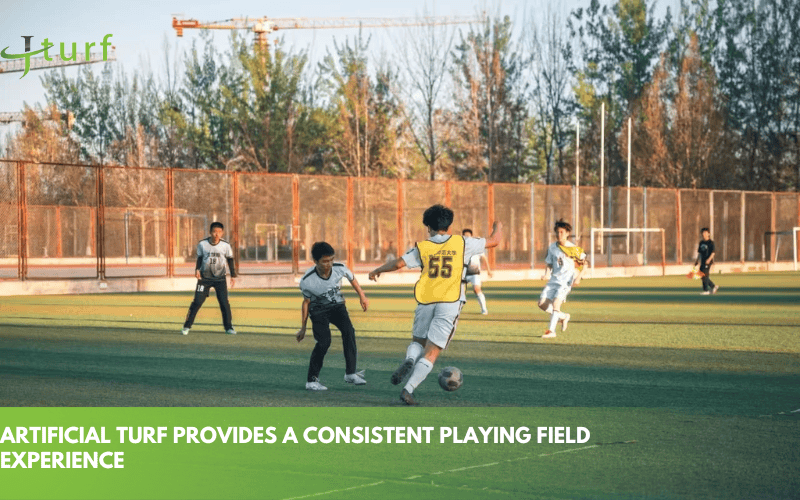
Professional Match Turf
- Characteristics: Meets FIFA Quality or FIFA Quality Pro standards, typically 50-60mm pile height, filled turf.
- Applications: International and professional matches.
Training Turf
- Characteristics: 30-50mm pile height, filled or non-filled, balancing durability and cost.
- Applications: Training grounds and community fields.
Multi-Purpose Turf
- Characteristics: 20-40mm pile height, adjustable density and inf բնակարանill for sports like football, rugby, or hockey.
- Applications: Multi-sport facilities.
Recreational Turf
- Characteristics: 10-25mm pile height, often non-filled, designed for low-intensity use.
- Applications: Schools, community parks, or small pitches.
How to Choose Artificial Turf for Your Football Field
Choosing the right artificial turf for your football field involves evaluating performance, durability, and cost. Here are the key factors to guide your decision:
Intended Use: Determine whether the field will be used for competitive games, practice, or both. This will influence the type of turf you choose.
Performance Characteristics: Focus on aspects such as shock absorption, traction, and energy restitution. These factors are crucial for player safety and enhance overall performance on the field.
Fiber Type:
- Monofilament: Known for its realistic appearance and durability, making it ideal for football.
- Polyethylene: Popular in professional sports facilities for its grass-like feel.
- Nylon: Very durable and suitable for high-traffic areas, though it may not be ideal for sliding sports.
- Polypropylene: A cost-effective option but generally less durable than other fibers.
Pile Height and Density: A pile height of 2-3 inches is recommended for football fields. Higher density turf offers a fuller look and better performance.
Drainage: Ensure the turf has adequate drainage to prevent water accumulation, which is vital for maintaining a safe playing surface.
Durability and Maintenance: Choose turf that can withstand heavy use and various weather conditions. While artificial turf requires less maintenance than natural grass, some systems may need more upkeep than others.
Budget Considerations: Establish a realistic budget as artificial turf can be a significant investment. Filled turf generally has a higher upfront cost but offers better durability, while non-filled options are more budget-friendly.
Local Climate: Consider how your local climate will affect the turf’s performance and lifespan. High-density turf is recommended for harsher climates.
Regulatory Compliance: If the field will be used for high school or college football, ensure the turf meets relevant league regulations.
Artificial turf, whether filled monofilament for professional venues or non-filled for community fields, delivers low-maintenance, year-round playability. Consult turf specialists to select a subtype that aligns with your field’s specific needs and performance goals.
Football Turf in Real-World
Football fields worldwide vary in turf type based on climate, usage, and performance needs. Below, we examine the most typical turf types in Japan, Australia, the United States, and the United Kingdom, showcasing real-world examples that highlight their preferences for artificial turf subtypes.
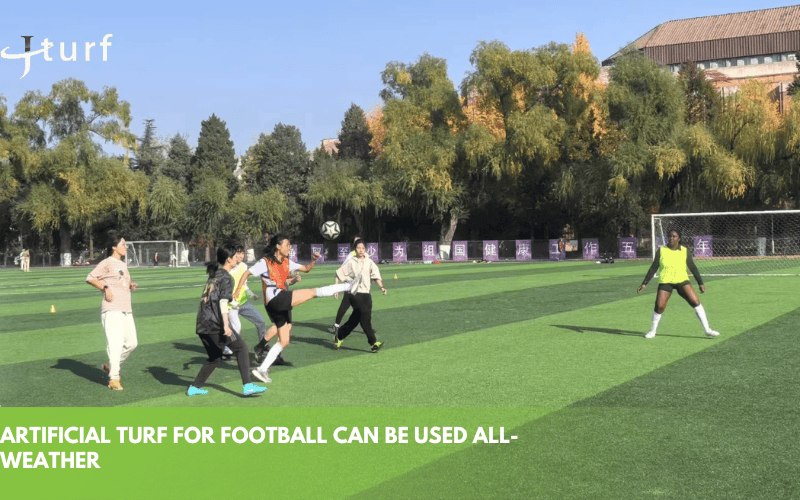
Japan: Filled Monofilament Artificial Turf
In Japan, filled monofilament artificial turf is the most common choice for football fields, particularly in professional and collegiate settings. The country’s humid climate and frequent rainfall make artificial turf ideal for consistent playability. High-density, filled monofilament turf (50-60mm pile height) with rubber and sand infill ensures durability and FIFA-compliant performance for high-traffic venues. A prime example is the Saitama Stadium 2002, a 63,700-capacity venue hosting J.League and international matches. Its filled monofilament turf supports frequent use while maintaining excellent ball control and player safety, reflecting Japan’s focus on advanced, weather-resistant surfaces.
Australia: Hybrid Turf
Australia often favors hybrid turf for its professional football fields, balancing the natural grass aesthetic with enhanced durability for multi-sport venues. The country’s warm climate and heavy field usage (e.g., for soccer, rugby, and Australian football) make hybrid turf, with synthetic fibers reinforcing natural grass, a practical choice. A notable example is the Melbourne Cricket Ground (MCG), which hosts A-League soccer matches alongside cricket and Australian football. Its hybrid turf withstands intense traffic while retaining a natural feel, aligning with Australia’s preference for versatile, high-performance surfaces.
United States: Filled Artificial Turf
In the United States, filled artificial turf dominates soccer fields, especially in Major League Soccer (MLS) and collegiate venues. The country’s diverse climate and multi-use stadiums (shared with American football) favor durable, low-maintenance surfaces like filled monofilament or fibrillated turf with rubber infill. An example is Lumen Field in Seattle, home to the Seattle Sounders FC. Its filled artificial turf (approximately 50mm pile height) supports soccer and NFL games, offering resilience under heavy use and variable weather, though it can heat up in summer, requiring cooling measures.
United Kingdom: Natural Grass and Hybrid Turf
The United Kingdom, the birthplace of modern football, traditionally prefers natural grass for its professional football fields, prized for player comfort and aesthetics. However, hybrid turf is increasingly common in high-traffic Premier League stadiums to enhance durability. Wembley Stadium, England’s national stadium, uses hybrid turf with less than 5% synthetic fibers woven into natural grass. This setup maintains the soft, natural feel players expect while withstanding frequent matches and events, making it ideal for the UK’s temperate climate and intense football schedule.
These case studies illustrate how Japan and the U.S. lean toward artificial turf for durability, while Australia and the UK blend natural and hybrid solutions for versatility and tradition. Selecting the right turf depends on balancing local conditions with performance needs.
Best Football Turf Supplier: JCturf
At JCturf, we are a leading manufacturer of premium artificial turf, providing innovative solutions for football fields and sports facilities worldwide. Our football turf range includes specialized turf types such as S-type monofilament for superior resilience, diamond-type monofilament for enhanced durability, wrap-type turf for added root protection, reinforced monofilament for high-traffic fields, non-filled turf for eco-friendly installations, and U-type monofilament for natural aesthetics. We also offer gateball-specific turf, including certified wide-leaf gateball turf and non-filled options for easy installation and reuse.
Committed to quality and sustainability, JCturf products are CE, SGS, ISO9001, ISO14001, and OHSAS18001 certified, meeting international standards for performance, safety, and environmental responsibility. Our UV-resistant, anti-aging materials ensure long-lasting, natural-looking turf that withstands high-frequency use. At JCturf, customer satisfaction drives our innovation, with “premium quality and eco-friendliness” at the core of every product.
Ready to elevate your football field? Contact JCturf today to explore our range of artificial turf solutions, from FIFA-certified filled monofilament to low-maintenance non-filled options. Our expert team is here to guide you through selection, installation, and maintenance to ensure optimal performance for years to come. Reach out now or visit our website to get started!
